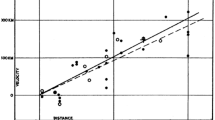Abstract
An attempt is presented to explain the red shift in terms of a theory based on two postulates: (1) perfect cosmological principle, and (2) postulate of the uniqueness of electromagnetic wavelength measurements.
It is assumed that the space of events is a static space, and the red shift is a consequence of the geometry of that space. In terms of the accepted postulates a theorem has been proved, according to which the luminosity distanceD is related to the red shift Δλ/λ0 by
wherec is the light velocity, andT, the Hubble constant.
It is shown that this relation is in agreement with astronomical data concerning the red shift and the distribution of galaxies. The hypothesis does not lead to the necessity of accepting any assumptions concerning the creation of matter at the origin of time or a continuous creation of matter, which have been postulated by certain other theories.
Similar content being viewed by others
References
Bellert, S.: 1967, O pewnym problemie związanym z pomiarem częstotliwości fali elektromagnetycznej [On a Problem Concerning Frequency Measurements of Electromagnetic Waves]. Wybrane zagadnienia elektroniki i telekomunikacji, P.W.N., Warszawa, 1968.
Adler, Bazin, Schiffer: 1965,Introduction to General Relativity, McGraw Hill, New York.
Bondi, H.: 1966,Cosmology, Cambridge University Press, Cambridge.
Bondi, H. andGold, T.: 1948, ‘The Steady State Theory of the Expanding Universe’,Monthly Notices, Roy. Astron. Soc. 108, 252–270.
Einstein, A.: 1955,The Meaning of Relativity, Princeton University Press, Fifth edition.
Einstein, A.: ‘Zur Elektrodynamik bewegten Körper’,Ann. Physik 17, 1905.
Hubble, E. P.: 1953, ‘The Law of the Redshift’,Monthly Notices Roy. Astron. Soc. 113, 658–666.
Hubble, E. P.: 1936, ‘The Luminosity Function of Nebulae. II’,Astrophys. J. 84, 270–295.
Hubble, E.: 1936, Effects of Red Shifts on the Distributions of Nebulae. Contributions from the Mount Wilson Observatory, No. 557.
Humason, M. L., Mayall, N., andSandage, A. R.: 1956, ‘Redshifts and Magnitudes of Extragalactic Nebulae,Astron. J. 97–162.
McVittie, G. C.: 1959, ‘Distance and Time in Cosmology’,Handbuch der Physik, Sternsysteme, Berlin.
McVittie, G. C.: 1965,General Relativity and Cosmology, London.
Landau, L. andLieszyc, E.: 1958,Teoria pola (Translated from Russian), Warsaw.
Takeno, H.: 1963, The Theory of Spherically Symmetric Space-Times, Hiroshima University, Japan.
Rindler, W.: 1966,Special Relativity, New York.
Sandage, A.: 1958, ‘Current Problems in the Extragalactic Distance Scale’,Astrophys. J. 127, 513–526.
Trautman, A., Pirani, F., andBondi, H.: 1964, Lectures on General Relativity.
Zonn, W. andRudnicki, K.: 1957, Astronomia gwiazdowa, Warsaw.
Author information
Authors and Affiliations
Rights and permissions
About this article
Cite this article
Bellert, S. On a new hypothesis concerning the red shift. Astrophys Space Sci 3, 268–282 (1969). https://doi.org/10.1007/BF00651032
Received:
Issue Date:
DOI: https://doi.org/10.1007/BF00651032




